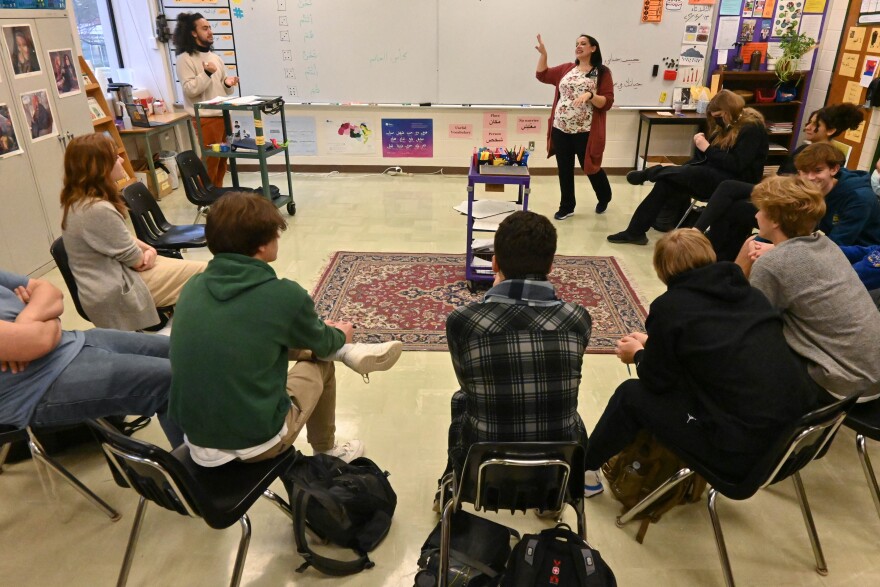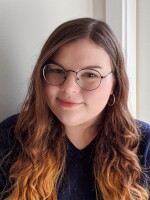Every Friday, nearly a dozen students sit in chairs circled around their classroom — no desks in sight — at Shawnee Mission South High School, watching a series of Arabic music videos.
At the end of every week, each of the high school’s Arabic language classes pick a music video and compete over who chose the best one. It’s not how most classes look — or sound — at the end of the week, but teacher Annie Hasan said it's a way to break down barriers and get students talking.
“It's not taught in a very traditional Arab way or American way,” Hasan said. “We sit in a circle and they're up and moving, constantly talking. We play a lot of games and there's a lot of interaction.”
As the child of a Palestinian father and an American mother, Hasan said teaching Arabic is a way for her to create a bridge between the two cultures and help them understand each other better.
The Arabic program got its start 30 years ago as part of the school district’s Center for International Studies. The center was created in 1991 and added the Arabic program a year later. Hasan said the anniversary of the program — which she believes is the country’s oldest Arabic program in a public high school — is something to celebrate.
“I think it's amazing that Overland Park, Kansas, had this vision and we're like in the middle of the continental United States,” Hasan said. “There was this vision in the 90s that ‘Hey, our world is shrinking. Let's find a way to give these students opportunities to help them be active change.’”

The program began right after the fall of the Berlin Wall, as the Soviet Union collapsed. David Wolfe, the center’s then-principal, said it was a time when everyone was talking about how changes around the world would impact education.
“It seemed like a wonderful time to develop a program that would allow people to more easily communicate with each other,” Wolfe said.
The district began offering classes on Arabic, Chinese, Japanese, and Russian studies, which Wolfe said were the least commonly taught languages in the country at the time. According to Hasan, these are languages deemed “critical” by the United States because there aren’t enough speakers to meet the needs of nonprofits, businesses or the government. Wolfe said he still remembers the reasons the program’s first students took the course.
“One of them was that they fell in love with the beauty of the script. And then, of course, there was the economic issue of oil and petroleum,” Wolfe said. “Several of them said they decided to study Arabic because they were going to go into the business world and wanted to be able to speak Arabic. So, you had both ends of an extreme, one from an artistic perspective and one from a business perspective.”
The language programs in the Center for International Studies were eventually each moved to a different high school in the district, with Arabic studies housed at Shawnee Mission South.

The reasons driving Shawnee Mission South students to learn Arabic now aren’t too different from those that started the program three decades ago. Hasan said a wide range of students take her classes, from those who want to learn every language they can to those who think it will stand out on their transcript.
That’s the case for Will Thiel, a junior who wants to go into international business. He said he started the program because he thought it was unique and hadn’t heard of another school offering classes on Arabic.
Still, he said it was intimidating to start learning a new language.
“When I first came into Arabic, my first day of freshman year, she started just speaking Arabic to us right off the bat and I was like, ‘I might be in a bit over my head right now,”’ Thiel said. “But then by the end of the week I was like ‘Wow, this is so much fun and I'm actually learning a lot.”
Other students are adding Arabic to their repertoire of other languages.
Joseph Goodman, a junior, has already learned English, Russian, German and French – but said he wanted to have a broader understanding of other languages. He plans to go into linguistics after high school, and said his favorite part of class is learning about grammar.
“I don't think it's common, but I really like learning about grammatical structures because I think that's the backbone of how you speak and it's an important part of a language,” Goodman said. “I always like having moments where I'm like, ‘Oh, that's weird, but it makes sense.’ And that's a lot of what grammar gives.”
Hasan said she starts class off slow, first by teaching the alphabet and then moving onto reading and writing. However, she said a large part of the class revolves around learning about the culture of Arab-speaking countries.
She said many students expand their knowledge beyond what they are learning in class, by watching Arab movies, shows or even working on calligraphy outside of class.
Our t-shirt design by Joseph Goodman! I am a native speaker of Arabic and I do NOT have this talent. Joseph has been studying Arabic for 3 yrs and has developed this beautiful skill ON HIS OWN! #OurSouthStory #OurSMSDstory #ISpeakArabic #CultureWins @theSMSD pic.twitter.com/bz9ukCR9W7
— Annie Hasan استاذة انام (@ustathaannie) December 16, 2022
That’s junior Riley Martin’s favorite part of class. Every semester the class does “Passport Projects” that have students report on an aspect of culture in an Arabic-speaking country. Martin said her latest project was about famous Arab film stars, combining her love of theater with what she’s learning in class.
Despite her plan to pursue a career in acting, Martin said she loves learning languages and has already picked up Chinese and Hebrew.
“I just think it's so cool because when you learn a language, you unlock this opportunity to communicate with millions of other people that you wouldn't have been able to as efficiently beforehand,” Martin said.
Martin said she’s surprised that the class has lasted so long, because when school districts need downsize, language programs can be one the first on the chopping block. Hasan credits the program’s longevity to support from an administration that recognizes that “we live in a smaller world.”
Since Hasan began teaching the program in 2009, she said it’s been steadily growing. When she started, there were 26 students in her classes. Now, she teaches around 55 students.
And while not all of her students will continue to study Arabic when they graduate, they won’t be leaving empty-handed.
“They sometimes leave my classroom and they are more experts on Arabic language and culture than maybe somebody who has already graduated college,” Hasan said.






